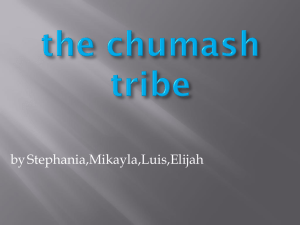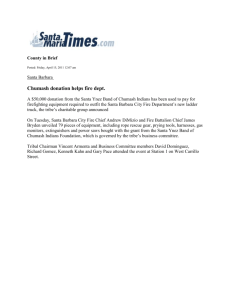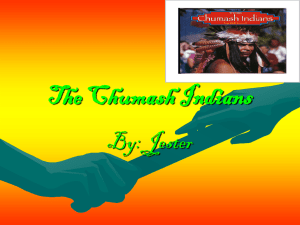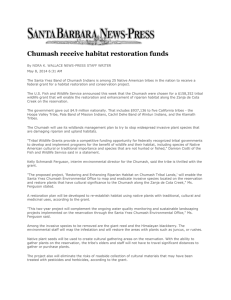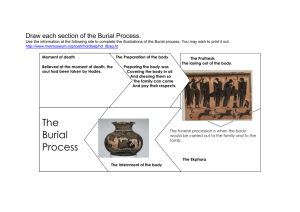Resolving cultural affiliation through multiple methods: A case study
advertisement
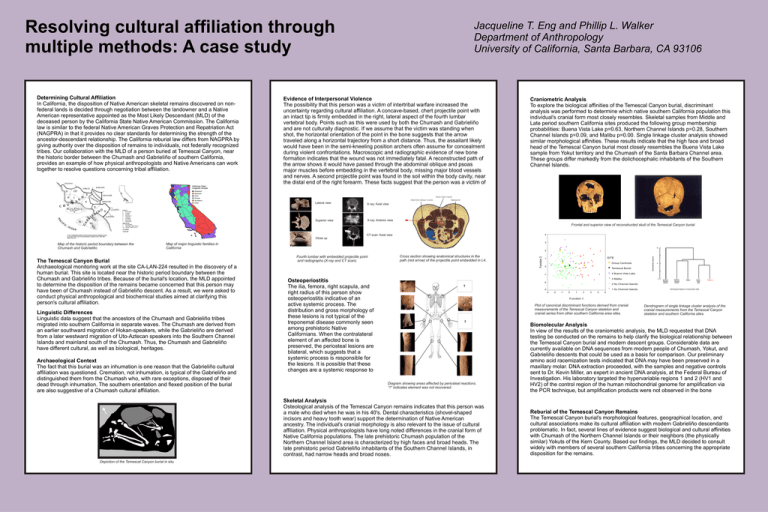
Resolving cultural affiliation through multiple methods: A case study Determining Cultural Affiliation In California, the disposition of Native American skeletal remains discovered on nonfederal lands is decided through negotiation between the landowner and a Native American representative appointed as the Most Likely Descendant (MLD) of the deceased person by the California State Native American Commission. The California law is similar to the federal Native American Graves Protection and Repatriation Act (NAGPRA) in that it provides no clear standards for determining the strength of the ancestor-descendant relationship. The California reburial law differs from NAGPRA by giving authority over the disposition of remains to individuals, not federally recognized tribes. Our collaboration with the MLD of a person buried at Temescal Canyon, near the historic border between the Chumash and Gabrieliño of southern California, provides an example of how physical anthropologists and Native Americans can work together to resolve questions concerning tribal affiliation. Jacqueline T. Eng and Phillip L. Walker Department of Anthropology University of California, Santa Barbara, CA 93106 Evidence of Interpersonal Violence The possibility that this person was a victim of intertribal warfare increased the uncertainty regarding cultural affiliation. A concave-based, chert projectile point with an intact tip is firmly embedded in the right, lateral aspect of the fourth lumbar vertebral body. Points such as this were used by both the Chumash and Gabrieliño and are not culturally diagnostic. If we assume that the victim was standing when shot, the horizontal orientation of the point in the bone suggests that the arrow traveled along a horizontal trajectory from a short distance. Thus, the assailant likely would have been in the semi-kneeling position archers often assume for concealment during violent confrontations. Macroscopic and radiographic evidence of new bone formation indicates that the wound was not immediately fatal. A reconstructed path of the arrow shows it would have passed through the abdominal oblique and psoas major muscles before embedding in the vertebral body, missing major blood vessels and nerves. A second projectile point was found in the soil within the body cavity, near the distal end of the right forearm. These facts suggest that the person was a victim of Lateral view X-ray: Axial view Superior view X-ray: Anterior view Craniometric Analysis To explore the biological affinities of the Temescal Canyon burial, discriminant analysis was performed to determine which native southern California population this individual's cranial form most closely resembles. Skeletal samples from Middle and Late period southern California sites produced the following group membership probabilities: Buena Vista Lake p=0.63, Northern Channel Islands p=0.28, Southern Channel Islands p=0.09, and Malibu p=0.00. Single linkage cluster analysis showed similar morphological affinities. These results indicate that the high face and broad head of the Temescal Canyon burial most closely resembles the Buena Vista Lake sample from Yokut territory and the Chumash of the Santa Barbara Channel area. These groups differ markedly from the dolichocephalic inhabitants of the Southern Channel Islands. Frontal and superior view of reconstructed skull of the Temescal Canyon burial CT scan: Axial view 4 Close up 3 The Temescal Canyon Burial Archaeological monitoring work at the site CA-LAN-224 resulted in the discovery of a human burial. This site is located near the historic period boundary between the Chumash and Gabrieliño tribes. Because of the burial's location, the MLD appointed to determine the disposition of the remains became concerned that this person may have been of Chumash instead of Gabrieliño descent. As a result, we were asked to conduct physical anthropological and biochemical studies aimed at clarifying this person's cultural affiliation. Linguistic Differences Linguistic data suggest that the ancestors of the Chumash and Gabrieliño tribes migrated into southern California in separate waves. The Chumash are derived from an earlier southward migration of Hokan-speakers, while the Gabrieliño are derived from a later westward migration of Uto-Aztecan speakers into the Southern Channel Islands and mainland south of the Chumash. Thus, the Chumash and Gabrieliño have different cultural, as well as biological, heritages. Archaeological Context The fact that this burial was an inhumation is one reason that the Gabrieliño cultural affiliation was questioned. Cremation, not inhumation, is typical of the Gabrieliño and distinguished them from the Chumash who, with rare exceptions, disposed of their dead through inhumation. The southern orientation and flexed position of the burial are also suggestive of a Chumash cultural affiliation. 2 Fourth lumbar with embedded projectile point and radiographs (X-ray and CT scan). Cross section showing anatomical structures in the path (red arrow) of the projectile point embedded in L4. SITE 1 4 Group Centroids 1 2 0 Temescal Burial Osteoperiostitis The ilia, femora, right scapula, and right radius of this person show osteoperiostitis indicative of an active systemic process. The distribution and gross morphology of these lesions is not typical of the treponemal disease commonly seen among prehistoric Native Californians. When the contralateral element of an affected bone is preserved, the periosteal lesions are bilateral, which suggests that a systemic process is responsible for the lesions. It is possible that these changes are a systemic response to 6 4 Buena Vista Lake -1 3 Malibu -2 2 No Channel Islands ? 1 So Channel Islands -3 -3 -2 -1 0 1 2 3 4 0 Southern Channel Islands Northern Channel Islands Malibu Buena Vista Lake Temescal Dendrogram Based on Craniometric Data 5 Function 1 Plot of canonical discriminant functions derived from cranial measurements of the Temescal Canyon skeleton and cranial series from other southern California area sites. ? Diagram showing areas affected by periosteal reactions. “?” indicates element was not recovered. Skeletal Analysis Osteological analysis of the Temescal Canyon remains indicates that this person was a male who died when he was in his 40's. Dental characteristics (shovel-shaped incisors and heavy tooth wear) support the determination of Native American ancestry. The individual's cranial morphology is also relevant to the issue of cultural affiliation. Physical anthropologists have long noted differences in the cranial form of Native California populations. The late prehistoric Chumash population of the Northern Channel Island area is characterized by high faces and broad heads. The late prehistoric period Gabrieliño inhabitants of the Southern Channel Islands, in contrast, had narrow heads and broad noses. Depiction of the Temescal Canyon burial in situ 12 3 Dissimilarity measure Map of major linguistic families in California Function 2 Map of the historic period boundary between the Chumash and Gabrieliño Dendrogram of single linkage cluster analysis of the cranial measurements from the Temescal Canyon skeleton and southern California sites. Biomolecular Analysis In view of the results of the craniometric analysis, the MLD requested that DNA testing be conducted on the remains to help clarify the biological relationship between the Temescal Canyon burial and modern descent groups. Considerable data are currently available on DNA sequences from modern people of Chumash, Yokut, and Gabrieliño descents that could be used as a basis for comparison. Our preliminary amino acid racemization tests indicated that DNA may have been preserved in a maxillary molar. DNA extraction proceeded, with the samples and negative controls sent to Dr. Kevin Miller, an expert in ancient DNA analysis, at the Federal Bureau of Investigation. His laboratory targeted the hypervariable regions 1 and 2 (HV1 and HV2) of the control region of the human mitochondrial genome for amplification via the PCR technique, but amplification products were not observed in the bone Reburial of the Temescal Canyon Remains The Temescal Canyon burial's morphological features, geographical location, and cultural associations make its cultural affiliation with modern Gabrieliño descendants problematic. In fact, several lines of evidence suggest biological and cultural affinities with Chumash of the Northern Channel Islands or their neighbors (the physically similar) Yokuts of the Kern County. Based our findings, the MLD decided to consult widely with members of several southern California tribes concerning the appropriate disposition for the remains.
